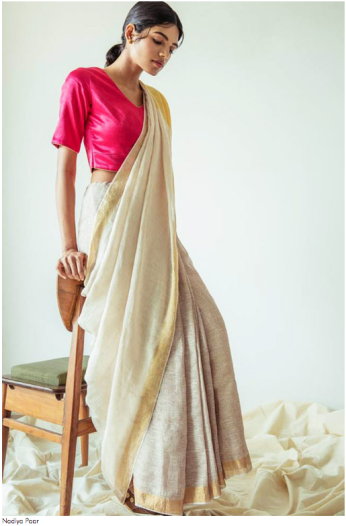Published: The Voice of Fashion, July 23, 2018

“If you travel where most of the world manufactures denim, you end up with having rivers that are turning blue,” says the founder of the premium Canadian brand Dutil Denim, Erik Dickstein, in the environmental documentary RiverBlue (2016). This is not the natural blue of beautiful Instagram travel photos but rather the harsh ‘filter’ of insoluble Azo dyes and hazardous chemicals like mercury, cadmium and lead from the fabric dyes used in the fashion industry. These chemicals are killing marine life and creating chronic illnesses like cancer and sensory loss in people.
While today most of the mass-manufactured clothes are made with toxic chemical dyes, until the late 19th century all dyes were made naturally through plants, insects or shellfish—the art of natural dyeing thrived in the Indian subcontinent.
Indigo, sourced from the indigofera flowering plant, creates blues and greens and is considered ‘magical’ because it lends itself to a range of hues and all kinds of fibres. Santanu Das, for Kolkata-based sustainable label Maku, uses only natural indigo: “It is a difficult colour to work with, but it is also neutral and liked by all. It cannot be controlled—it is impossible to get an identical shade. That by itself is human and philosophical. It forces you to understand the limitations of a medium and craft and to take a step forward.”
While India has perfected colours like red and black—made from madder root and iron filings respectively—and in combination with other substances created hundreds of natural tints, Das believes that the natural shade card of India comprises “the seven different colours of white”. He adds, “We have a huge culture of wearing undyed things: dye is a luxury, as is pattern and printing.”
A number of Indian designers today have embraced kora (undyed) fabric and natural dyes as a part of their sustainable fashion initiatives as a manifesto, like Goa-based OmArts; as a part of capsule collections like Ahmedabad-based Tilla; or comprising a large portion of the collections, like Mumbai-based Anavila Misra’s linens (for label Anavila) which showcase undyed fabric or natural indigo, while other pieces use Azo-free chemical dyes.

Today, in India, centres and artisans in Kutch, Bengal, Goa, Pondicherry and Hyderabad among others are working with natural dyes. In the sustainable fashion collections showcased at Lakmé Fashion Week Summer/Resort ’18 under the Usha Silai label, Amit Vijaya and Richard Pandav teamed up with women who are known for their work in natural dyes from a region near Jaipur.
Rekha Bhati and Nikki Kali of Kishmish, who work with the NGO Kala Swaraj, believe, “Everything has energy. If the process of making a garment is thoughtful, with kindness to the planet, you can feel it when you wear it.” Besides being good for the environment, naturally-dyed fabrics are a healthier option. Kolkata-based designer Divya Sheth points out, “Dyes penetrate our bodies; natural dyes like those made from turmeric and madder are not only therapeutic but also nourish and replenish the skin.”
But a naturally-dyed garment is not without challenges. Das, who dyes yarn in his workshop before sending it out for weaving, says, “There are no shortcuts for natural dyes—people don’t like to use them because it is a nightmare to work with them. The colour bleeds and fades. They cannot retain the colour ever after.” Sheth, who uses natural dyeing for 85 percent of her textiles, agrees that the process is tricky. “There’s a scarcity of artists, it is a tedious and laborious (manual) process. The colours change batch wise — the inconsistency means that no two garments would ever be the same. As much as we love this, some unaware clients take this as a defect.”
Soham Dave for his eponymous Ahmedabad-based sustainable label that works with Kutch-based artisans for dyeing avoids chemical dyes as much as possible. He stresses upon thinking about the entire process of production over dyes in isolation. He admits that the natural dyeing process is more expensive, as it involves a lot of rejection and handling, with dependency on the unpredictability of nature—wind or pollutants in water may impact the production. He says, “I have not come across many successful ways to mass produce it.”

Scale perhaps is the biggest consideration of naturally-dyed garments, along with the considerable need for freshwater. Ruby Ghuznavi, activist and advocate for craft and natural dyes in Bangladesh, points out in a conversation with colour specialist Fiona Coleman in an interview on The Kindcraft, an independent online magazine, “There is a limit to the capacity you can produce. If you increase the capacity, there’s a danger you’ll lose the quality. And because we’re starting to make our colour solution from scratch every morning, there are a lot of points at which the process can go wrong. The minute you start making 1,000 pieces instead of 100, maybe one or two will not be colourfast.”
Designers like Aratrik Dev Varman of Tilla grapple with how a naturally-dyed garment is perceived in the market. Says Dev Varman, “You have to tell people to expect natural blemishes and fading of colours. It would be misleading to compare it to something that is chemically dyed in a factory. The challenge is educating and convincing people that despite all this, it is still a better product.” A consumer who has been conditioned to appreciate industrial homogenised products and accept it as the benchmark of perfection and quality is unlikely to embrace the uniqueness of a handmade, naturally-dyed garment which will age gracefully.
And yet, Coleman on The Kindcraft, perhaps referring to a more evolved British consumer with regard to sustainability, believes that education has changed customers and, if it is marketed as a natural product or a natural dye, the consumer would be happy to have that inconsistency. That may be a sign of things to come in India. In the standardised Pantone world of today, the variations that are seen in a naturally-dyed fabric are a call to celebrate the beauty of imperfections, just as nature would have it.

Brief Timeline Of Natural Dyes In The Indian Subcontinent
2600 BCE Natural dyeing techniques developed during the Indus Valley civilisation and spread worldwide through trade routes.
1498 Vasco da Gama discovered the maritime route to India. Indigo was the first valuable ‘spice’ to be exported by Portuguese traders.
Mughal Era (16th-18th centuries) Natural dyeing techniques developed finesse under the patronage of the Mughal emperors, who particularly loved indigo which gave the popular blues and greens.
The 19th century Bengal became the world’s main source of indigo.
1856 The discovery of aniline dyes by British scientist William Henry Perkin, and their spread to colonial countries. It led to post-independence India no longer retaining its tradition of natural dyes except in a few rural communities.
1859 Unjust production methods led to the Blue Mutiny during the British Raj.
1897 German company BASF launched the synthetic ‘Indigo Pure BASF’ in the market.
The 70s Kamaladevi Chattopadhyay initiated the movement for the revival and promotion of natural dyes in India (and Bangladesh).
1990 Activist and advocate for craft and natural dyes, Ruby Ghuznavi, started fair-trade organisation Aranya in Bangladesh, which has 3000 artisans.
2009 Dr Himadri Debnath, deputy director of the Botanical Survey of India (BSI) in Kolkata, found a unique 15-volume set (with 3500 samples) of Specimens of Fabrics Dyed with Indian Dyes compiled by British Victorian dyer Thomas Wardle, which was believed to have been lost.
2013 Colours of Nature, Auroville—which began manufacturing natural blue jeans with organic indigo dye and local cotton yarn in 1993 collaborated with Levi’s to launch the first truly organic 511 jeans.
— Compiled from Marg’s Colours of Nature: Dyes From The Indian Subcontinent (December 2013)
Examples of Sources of Natural Dyes
Blue and Green: Indigofera plant, neel and woad leaves, girardinia fibre.
Red: Cochineal, lac insect, root and bark of mulberry, madder root, henna leaf, red beet, sappan, red sandalwood, walnut shell, bark and leaf, Indian almond tree bark.
Yellow: Himalayan rhubarb root, marigold flower, pomegranate peel, mango, lodh, saffron, turmeric, ivy bark, cotton flower, teak leaf.
Purple: Muricidae sea snails, logwood.
Brown: Octopus, cuttlefish, cutch tree, amla, ginger root.
Black: Iron and jaggery, sal bark, marking nut.
QUICK CARE TIP
A naturally-dyed garment needs personal care. Hand-wash with cold water using a mild detergent, or better yet, reetha (Soapnut).



 Banner photo, from left to right: Doodlage, Tilla, Ka-sha by Karishma Shahani Khan
Banner photo, from left to right: Doodlage, Tilla, Ka-sha by Karishma Shahani Khan

 Padmaja
Padmaja















